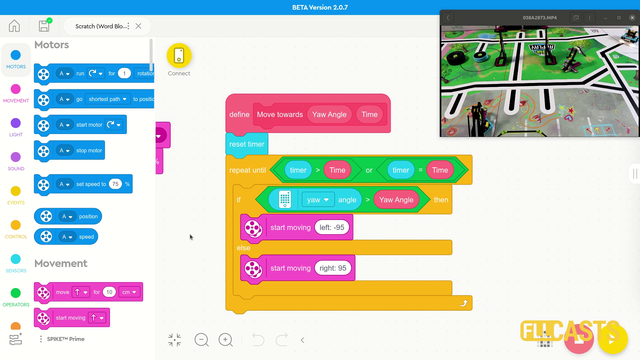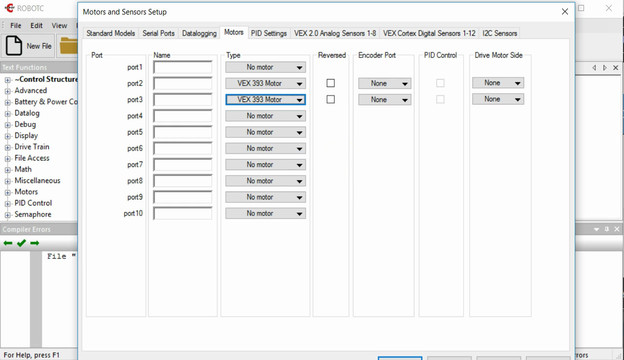
Camera on wheels. Course section Intro
Let's put everything that we have learned so far into practice. Let's make a spy robot!
- #427
- 19 Apr 2017

Let's put everything that we have learned so far into practice. Let's make a spy robot!


An interesting question that has arise is whether we can use the LEGO Mindstorms EV3-G Software to program the NXT brick. In this episode we will go through the blocks from the EV3-G Software and see which works with the NXT Hardware and which does not.


In this video tutorial we use the LEGO Education SPIKE Prime Motion Sensor to reach a mission model on the field. It's a basic use of the motion sensor that we will extend in the next few tutorials and in the same time we take the opportunity to demonstrate what a MyBlock is and how to develop one. As a result of this video you will learn how to make the program easier to read and maintain by organizing the blocks in the program in special MyBlocks that couple them all together.


With this first tutorial on the Motion Sensor in the LEGO MINDSTORMS Robot Inventor course we demonstrate the basic algorithm for moving in a straight line with the Motion Sensor. From here all the other algorithms are modifications, and if you know the basic it will be easier to tweak the behavior for your particular challenge


For the current specific example we need two parts - the diode and the controller. In this episode we would show you which part is the controller, which are the jumpers and finally we would choose a diode.


Every turn is a circular motion and we will review the three types of turns from this point of view.


This is a 10 out of 10 video tutorial that demonstrates the consistency and reliability of the robot that accomplishes the Unlock Cargo Plane mission. The attachment is an active attachment with gear wheels. It has a single lever constructed from 2 beans and we use this attachment to push on the mission model.


As a result from the previous two videos we have a diode that is blinking. What will now happen with the diode if we remove the power and change the position of the legs.

Following the previous tutorials from the course, implement the calibration of the minimum and maximum values.


Is it better to do fast turns or slow turns? Should you save some time by turning fast or should you be more precise by turning slow. Where is the balance? This video tutorial demonstrates exactly this for LEGO Education SPIKE Prime robot, their motion sensor and an ever occurring question on FIRST LEGO League competition which is how to find the balance and where is the balance.


In this tutorial we go through the VEX IQ Challenge. Most of the challenges are related with manipulating objects. The most common object used in competitions are balls. That is why we take a look at a simple mechanism that can be used for throwing a ball.

Let's move with the VEX EDR robot using its motors, the wheels and some RobotC programming. We devide the program in three parts - Connect the motors, program the controller and turning.


An advanced but understandable description of how to program the mindstorm robot to move in a regular n-gon like pentagon, hexagon etc. (Yes, we know math). We have also included notes on the used formulas. A must see for each of you who would like to master the robot movements.


If you've done the calculation following the previous tutorials you would arrive at a result of 18.75 rotations. But this is not the correct answer. The calculation is wrong, because the math model that we've built, although kind of obvious, is not correct. When experimenting the correct number of rotations would be 37.5. This is a large difference. Two times larger. Exactly two times large. Something should be happening here - and this thing is "planetary mechanism"

Calculate the number of rotations you have to do with the motor to rotate the final small 8 teeth driving gear wheel to 1.25 rotations?


This is a 10 out of 10 tutorial, demonstrating the consistency and reliability of the active attachment for switching the engine in this mission. The power is transferred through a system of gear wheels to a lever at the end. We presume that the robot is already positioned.


What should you as a teacher know when the students are trying to achieve a program and robot attachment that could reproduce their behaviour 9 out of 10 times.


In this video we discuss the durability of the construction of LEGO robots and how do we make them more durable.


The comunication between the motors and the controller should be configured in the RobotC software. Each motor could be connected on a different port and the goal of the video is to show you how.


Safety notice: There is current flowing in this device and you can touch the device with your bear hands. This is not dangerous, but there are a few things that you should consider especially in class.


The reason why you would want to watch this tutorial is because it demonstrates one of the most reliable ways to know where you are on the field and to accomplish missions successfully and this is aligning to a line. In the tutorial you will also see how a parallel program is developed and who parallel programs could be used in a meaningful way.


In this video tutorial we accomplish the basketball mission from the FIRST LEGO League 2020 reply competition. We use the LEGO Education SPIKE Prime competition robot called Gazon. You will learn the principles of accomplishing a mission of two parts - put the ball in the basket and lift the basket.


How to control the arm of the push bot using the two triggers on the GamePad of the FTC Push Bot?


In this episode we would modify the blinking diode program so that the diode will stay on for four seconds.


The last thing you want to lose during every robotics competition is time for changing the programs on the brick. This could require seconds and as we all know every second counts. There are a few ways to improve the way of choosing programs. In this video lesson we will show you how to program a menu directly in your program.


This video tutorial is part of the 10 out of 10 series at FLLCasts and we will demonstrate how to accomplish the FIRST LEGO League 2020 RePlay competition mission called Innovation Project. Our goal is to push the construction to the require place on the field. What you will learn with this tutorial is how to place a random construction in the base and push/pull it to a place on the field 10 out of 10 times.


Pivot turns require fractions of rotations, a number between 1 and 2. Sometimes it is more convenient to use degrees.
In the software, you can change the "move block" to use degrees.